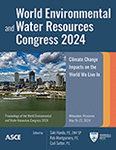Drinking Water in Oil and Gas Wells to Be Abandoned—A Technical Guide for the Oil Industry to Supply Water to Resource-Poor Communities
Publication: World Environmental and Water Resources Congress 2024
ABSTRACT
Around the world, operators of oil and gas properties periodically face the necessity to abandon wells. This is a very dynamic activity during the whole life of an oil and gas endeavor, which intensifies at the final production stage of the project. Worldwide, significant quantities of water are still unexplored; nevertheless, there are millions of people without access to water. This paper presents the methodology to identify those hydrocarbon wells, planned for abandonment, which may be wells capable of supplying water in quantity and quality suitable for human usage, agriculture, or industrial purposes; and addresses the engineering practices to make feasible the supply of such a precious resource to the communities local to the oil and gas field. This work was developed to serve as a guide to operators, regulators, and other stakeholders of the oil and gas industry so they may consider these alternative practices prior to the process of fully abandoning oil and gas wells.
Get full access to this chapter
View all available purchase options and get full access to this chapter.
REFERENCES
Groom, N. (2020). “Millions of abandoned oil wells are leaking methane, a climate menace.” Accessed November 10, 2023. <https://www.reuters.com/article/idUSKBN23N1P3/ >.
Marcacci, S. (2020). “Plugging Abandoned Oil Wells Is One ‘Green New Deal’ Aspect Loved by Both Republicans and Democrats”. Accessed November 15, 2023. <https://www.forbes.com/sites/energyinnovation/2020/09/21/plugging-abandoned-wells-the-green-new-deal-jobs-plan-republicans-and-democrats-love/?sh=6d4cf7fc2e10 >.
WHO (World Health Organization). (2006). Chilton, J. Chorus, I. Protecting Groundwater for Health. Managing the Quality of Drinking water Sources, groundwater, and public health. First published 2006. London, UK: WHO.
Willis, W. D. (2019). Practical Hydrogeology: Principles and Field Applications. 3rd ed. McGraw-Hill. New York, NY, USA.
Encyclopedia Britannica. Science & Technology. (2023). “Sedimentary basins with oil & gas producing areas.” Accessed November 18, 2023. <https://media.web.brittanica.com>.
WHO. (2017). Guidelines for drinking‑water quality. Fourth edition incorporating the first and second addenda. Geneva, Switzerland: WHO.
United Nations World Water Development Report. (2023). Partnerships and cooperation for water. Paris, France.
Hanna, R., Spooner, F., and And Roser, M. (2019). Clean Water and Sanitation. Drinking Water. Our World Data. Oxford Martin School. First published 2019. Oxford, U.K.
US EIA (Energy Information Administration of United States). (2023). International Statistics. Petroleum and other liquids data by Country 2018-2022. EIA, Washington DC, USA: EIA.
The Premier Research Platform for Long Term Investors 2023. “Clean Water Access by Country 2016 to 2020”. Accessed November 15, 2023. <https://www.macrotrends.net/countries/ranking/clean-water-access-statistics >.
Craft, B. C., and Hawkins, M. F., Jr. (1968). Applied Petroleum Reservoir Engineering. Prentice Hall Inc, Hoboken, NJ, USA.
NORSOK Standard D-010. (2013). Well integrity in drilling and well operations. Revision 04. Lysaker, Norway: NORSOK Standard.
AAPG (American Association Petroleum Geologist). (2022). Reservoir Engineering Methods - Fundamentals of fluid Flow. Tulsa, USA: AAPG.
Cushman, J. H., and Tartakovsky, D. M. (2016). The Handbook of Groundwater Engineering, CRC Press, Boca Raton, FL, USA.
Haluszka, A., Wilmot, W., and MacMillan, G. (2016). “Groundwater Supply Management vs. Petroleum Reservoir Management”. Geoconvention - optimizing resources chapter, Calgary, AB, Canada.
SPE (Society of Petroleum Engineers). (2015). Estimating Permeability from Well Log Data. SPE, Dallas, TX, USA.
Kurtulus, B., Yaylım, T. N., and Avşar, O. (2019). The Well Efficiency Criteria Revisited Development of a General Well Efficiency Criteria Based on Rorabaugh’s Model. MDPI publisher, Basel, Switzerland.
Duru, U. I., Nwanwe, O. I., Nwanwe, C. C., Arinkoola, A. O., and Chikwe, A. O. (2021). “Evaluating Lift Systems for Oil Wells Using Integrated Production Modeling: A Case Study of a Niger Delta Field.” Journal of petroleum Engineering & Technology. 2021; <https://www.researchgate.net/figure/Most-Commonly-used-Artificial-Lift-Systems >.
BH (Baker Hughes). (2020). Submersible Pump Baker Hughes Handbook Version 13- Section 3: ESP Downhole Equipment. Claremore, OK, USA.
Information & Authors
Information
Published In
History
Published online: May 16, 2024
ASCE Technical Topics:
- Business management
- Drinking water
- Energy engineering
- Energy infrastructure
- Environmental engineering
- Groundwater
- Industries
- Infrastructure
- Lifeline systems
- Organizations
- Practice and Profession
- Water (by type)
- Water and water resources
- Water management
- Water policy
- Water quality
- Water resources
- Water supply
- Water treatment
- Wells (oil and gas)
- Wells (water)
Authors
Metrics & Citations
Metrics
Citations
Download citation
If you have the appropriate software installed, you can download article citation data to the citation manager of your choice. Simply select your manager software from the list below and click Download.
